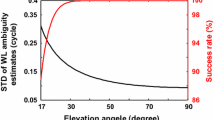Abstract
The upcoming modernization of the GPS signals will allow for measurements on an additional third frequency L5 located at 1176.45 MHz. To take advantage of carrier-phase measurements on this new signal, the strategies for integer ambiguity resolution, required for centimeter-level accuracy, may need to be revised. The Least-squares Ambiguity Decorrelation Adjustment method remains perhaps the most powerful tool for finding the best combinations based on a complete decorrelation of the variance–covariance matrix related to the ambiguities. However, the computational load of that method plus the opportunity to comprehensively study the interaction of multiple frequencies suggest a reconsideration of approaches using predefined combinations between frequencies is not out of place. In this paper a systematic investigation is made of all possible triple-frequency geometry-free carrier-phase combinations which retain the integer nature of the ambiguities. The concept of the lane-number is presented to unambiguously describe the wavelength of a particular combination. The propagation of the observation noise and of the ionospheric bias on these combinations is presented. These noise and ionospheric amplification factors are analysed with respect to the resulting wavelength, in an effort to highlight optimal combinations characterized by a long wavelength, low noise and limited ionospheric impact.
Similar content being viewed by others
References
Blewitt G (1989) Carrier phase ambiguity resolution for the GPS applied to geodetic baselines up to 2000 km. J Geophys Res 94(B8): 10187–10203
Braasch MS, Van Dierendonck AJ (1999) GPS receiver architectures and measurements. Proc IEEE 87(1): 48–64
Cocard M, Geiger A (1992) Systematic search for all possible widelanes. In: Proceedings of the sixth international geodetic symposium on satellite positioning, Columbus, pp 312–318
Collins JP (1999) An overview of GPS inter-frequency carrier phase combinations. Unpublished paper, retrieved May 25, 2007 from: http://gauss.gge.unb.ca/papers.pdf/L1L2combinations.collins.pdf
Feng Y, Rizos C (2005) Three carrier approaches for future global, regional and local GNSS positioning services: concepts and performance perspectives. In: Proceedings of ION-GNSS 2005, Long Beach, pp 2277–2287
Han S, Rizos C (1999) The impact of two additional civilian GPS frequencies on ambiguity resolution strategies. In: Proceedings of ION-AM1999, Cambridge, pp 315–321
Harris RA (1997) Direct resolution of carrier-phase ambiguity by ‘bridging the wavelength gap’. ESA Publication “TST/60107/RAH/Word”
Jung J, Enge P, Pervan B (2000) Optimization of cascade integer resolution with three civil GPS frequencies. In: Proceedings of ION-GPS2000, Salt Lake City, pp 2191–2200
Mordell LJ (1969) Diophantine equations. Academic, New York
Odijk D (2003) Ionosphere-free phase combinations for modernized GPS. J Surv Eng 129(4):165–173. doi:10.1061/(ASCE)0733-9453(2003)129:4(165)
Richert T, El-Sheimy N (2007) Optimal linear combinations of triple-frequency carrier phase data from future global navigation satellite systems. GPS Solut 11(1):11–19. doi:10.1007/s10291-006-0024-x
Teunissen PJG (1995) The least-squares ambiguity decorrelation adjustment: a method for fast GPS integer ambiguity resolution. J Geod 70: 65–82
Teunissen PJG (1995b) The invertible GPS ambiguity transformations. Manuscripta Geodaetica 20(6): 489–497
Teunissen PJG (1999) An optimality property of the integer least-squares esrtimator. J Geodesy 73: 587–593
Teunissen PJG (2001) GNSS ambiguity bootstrapping: theory and applications. In: Proceedings of internetional symposium on kinematic systems in geodesy, geomatics and navigation (KIS2001), pp 246–254
Teunissen PJG, Odijk D (2003) Rank defect integer estimation and phase-only modernized GPS ambiguity resolution. J Geod 76:523–535. doi:10.1007/s00190-002-0285-2
Teunissen PJG, Joosten P, Tiberius C (2002) A comparison of TCAR, CIR and LAMBDA GNSS ambiguity resolution. In: Proceedings of the 15th international technical meeting of the satellite division of the institute of navigation (ION GPS’02), Portland, pp 2799–2808
Verhagen S, Joosten P (2004) Analysis of integer ambiguity resolution algorithms. In: Proceedings of the European navigation conference, GNSS 2004 merging science and application, 16–19 May, Rotterdam, 11 p, and Eur J Navig 2(4):38–50
Author information
Authors and Affiliations
Corresponding author
Rights and permissions
About this article
Cite this article
Cocard, M., Bourgon, S., Kamali, O. et al. A systematic investigation of optimal carrier-phase combinations for modernized triple-frequency GPS. J Geod 82, 555–564 (2008). https://doi.org/10.1007/s00190-007-0201-x
Received:
Accepted:
Published:
Issue Date:
DOI: https://doi.org/10.1007/s00190-007-0201-x




